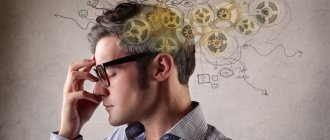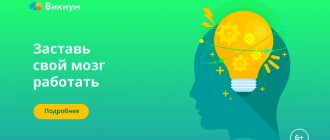In the field of brain development, there is the concept of cognitive abilities. These abilities develop independently, especially in childhood, but as you grow older, this process should be supplemented with various exercises so as not to remain at a primitive level. In fact, all interactions a person has with the world around him affect him either positively or negatively. Therefore, let’s figure out together how cognitive abilities today affect a person’s quality of life and how to develop them qualitatively.
Definition
Cognitive abilities are a set of brain processes involved in understanding the world around us. With the help of them we perceive, process, sort, remember, store and reproduce information.
Cognitive abilities include:
- perception,
- attention,
- memory,
- thinking,
- speech,
- imagination.
These are those mental processes that help to effectively interact with information coming from the senses. All of them are closely interconnected and complement each other. If some process is lame, then others partially take over its function. This embodies the principle of flexibility and compensatory psyche.
When we characterize a person as “smart,” we are placing a high value on his cognitive abilities.
Heredity and congenital characteristics affect the quality of cognitive functions. But to a much lesser extent than was previously believed. A person’s purposeful work on their development plays a primary role.
This means that a person who has average innate abilities, but regularly trains his cognitive functions, will soon overtake someone who is naturally gifted, but does not develop his inclinations.
Imagination exercises
Imagination distinguishes us from animals. This is what biologists say: seals deny this fact. Develop your imagination to be able to navigate different points of view, experience subconscious experiences, and think creatively.
- Imagine in your head how you play the piano. How are your fingers positioned? At what speed are they moving? What melody is being played - hear the sound, catch the rhythm, try to move to the beat. Think of a story - why this composition was born, what feelings it is associated with. Do the exercise in silence.
- Print out several copies. On each one, complete the picture in accordance with the random theme that arose in your head (animals, body parts, accessories, etc.).
I mentally drew the girl. And you?
- Name associations with the numbers 12, 7, 4, 56, 11. When these numbers run out, come up with new ones and repeat the exercise.
- Look at the picture. Imagine the music with which she is associated. Write down a story that, in terms of dynamics (cheerful, cheerful, sad, etc.) repeats the composition in your head.
Radcliffe as a corpse in The Swiss Army Knife
- Think about the last movie you watched. Transfer the script to another era: how will the plot be transformed, will the characters’ characters change, will the ending be the same?
What are cognitive abilities?
Let's take a closer look at all human cognitive abilities and figure out how to develop them.
Perception
Perception is a set of mental processes that are responsible for reflecting in the mind images of objects that directly affect the senses.
Perception should not be confused with sensations, because this is a more complex process. Unlike sensations, which reflect individual properties of objects (cold, bitter, light), perception forms a holistic image.
More than 100 cool lessons, tests and exercises for brain development
Start developing
Perception is for the most part a reflex process, which means it occurs without the participation of consciousness. Therefore, it is considered to be the simplest cognitive function. But this in no way diminishes its importance. It is perception that provides “food” for more complex cognitive functions. Defects of perception leave a serious imprint on the functioning of the entire psyche and the capacity of a person.
There are several conditions on which the level of development of perception depends:
- Active movement. To form spatial perception, motor activity is necessary.
- Feedback. To correct errors in a timely manner, a person must have the opportunity to compare the image of a perceived object with the object itself.
- Sufficient amount of incentives coming from outside. Sensory hunger leads to perception disturbances.
- Variety of incentives.
In adulthood, perception can be developed through training of the senses. Exercises are used both to train each analyzer individually and for all of them in a complex.
Attention
Attention is a mental function responsible for the selectivity of information perception. Attention allows you to isolate significant ones from billions of internal and external stimuli and concentrate on them.
The better developed attention is, the longer a person is able to hold some object in consciousness without being distracted by extraneous stimuli.
Attention can be compared to the light of a flashlight in the evening twilight. We see objects on which light falls clearly and clearly. While everything around has only vague outlines.
The importance of this cognitive ability cannot be overstated. It is the basis for the effective operation of all other functions. We will not be able to remember and reproduce information if it is not in the focus of our attention. Accordingly, we will not be able to perform any logical operations with it.
There are two types of attention:
- Involuntary attention is activated without the participation of the will. For example, in response to a strong stimulus: a loud sound, a bright flash of light. We reflexively direct attention to an object that we assess as dangerous. Also, attention itself flows towards potential pleasure. We don't need to specifically focus on what feels good. It happens naturally.
- Voluntary attention is a conscious process. A person activates it through willpower. When we talk about training attention, we mean voluntary attention. The longer you can consciously focus on an object or action, the higher the quality of your attention.
To train attention, Schulte tables, wedge-shaped tables, and various pictures are used in which you need to look for hidden objects or differences.
All these exercises are in our article on how to develop attention. Be sure to check it out.
Memory
Memory is a set of mental processes for consolidating, storing and reproducing received information.
Memory plays a huge role in cognition and transformation of the world. It is thanks to it that a person can learn, gain new knowledge and develop new skills.
What is the psychophysiological mechanism of memory? In the process of interaction with information, foci of excitation arise in certain areas of the brain. Neurons (brain cells) exchange electrical impulses and form synaptic connections with each other. The electrical signal is transmitted from neuron to neuron, and its entire path is imprinted in the brain in the form of neural circuits. Subsequently, the brain is able to reproduce this path under certain conditions.
There are 86 billion neurons in the human brain. Each of them is capable of forming up to 10 thousand synapses with other neurons. The capacity of each neuron is 4.7 bits. This means that the memory capacity as a whole is approaching a thousand terabytes.
There are several main classifications of memory.
According to the nature of mental activity, memory is divided into:
- motor,
- figurative,
- verbal-logical,
- emotional.
According to the duration of consolidation of information, memory is divided into:
- operational,
- short-term
- long-term
According to the nature of the goals of the activity, memory is divided into:
- free
- involuntary.
There are a huge number of memory training methods. You can get acquainted with some of them in our article on how to improve your memory. I also recommend reading about how to remember information.
Thinking
Thinking is the highest level of human knowledge. At this level, connections between objects are formed, their classification, systematization, and properties are identified. With the help of thinking, a person gains knowledge that cannot be obtained with the help of the senses.
Thinking is a complex mental process. It takes years to form. There are several stages of thinking development:
- Visual and effective thinking is typical for children under 3 years of age. It works directly during interaction with objects: the child learns to assemble a pyramid, sort toys by shape, etc.
- Visual-figurative thinking predominates between the ages of 3 and 7 years. During this period, the child is able to operate with images of objects to solve problems without direct contact with the objects themselves. For example, imagine what the person depicted in the picture will do.
- Verbal-logical (abstract) thinking is the highest level of development of thinking. It functions on the basis of language and is responsible for the use of abstract concepts and logical constructs, that is, that for which there is no material expression.
It is noteworthy that the process of development of thinking in each individual person repeats the process of evolution of thinking in humanity as a whole. Among primitive people, visual-effective thinking first arose, then it evolved into visual-figurative thinking, and only then took shape into abstract thinking.
Thinking requires constant development from a person. If this does not happen, then it begins to degrade. To train your thinking, you can use logical and mathematical problems, crosswords, special exercises and simulators. All this is in our article on how to develop thinking.
Speech
Speech is a complex mental process unique to humans. In addition to communication, it performs a number of other functions, including cognitive ones.
A person’s idea of the world is formed in the process of mastering his native language. With the help of speech, a person is able to obtain knowledge about objects and phenomena without having direct contact with them. This significantly expands the boundaries of knowledge and gives us truly unique opportunities.
Speech is closely related to all other cognitive functions. It affects even such basic cognitive abilities as perception. For example, scientists have found that people are unable to distinguish colors for which they do not have a definition in their language.
You need to develop your speech in several directions at once: replenish your vocabulary, work on diction and articulation, improve the expression of thoughts in oral and written form.
Imagination
Imagination is the ability of consciousness to generate new images, ideas, ideas based on previously acquired knowledge.
Imagination plays a key role in processes such as modeling, planning, and creativity. The world we live in now is the result of the imagination of our ancestors.
The specificity of imagination as a cognitive function lies in the processing and comprehension of previously acquired experience. In this regard, imagination is similar to thinking. The result of both processes is advanced reflection. But the only difference is that thinking operates with concepts and categories, while imagination operates with images.
Psychologists identify 5 main techniques of imagination:
- Agglutination. Or, in simple words, gluing. A new image is created by connecting two or more existing objects. For example, a centaur is the result of agglutination of a man and a horse.
- Hyperbole, litotes. The first means exaggeration, the second means reduction. An example of hyperbole is a giant. An example of litotes is Thumb Boy.
- Accentuation. This technique is used to highlight a specific characteristic. For example, Buratino has a long nose.
- O impersonation. The essence of the technique is to endow inanimate objects with the characteristics of living beings. Almost no fairy tale can do without this technique.
- Typing. Endowing an image with characteristics typical of a whole group of similar objects or phenomena.
We can use these techniques to train our imagination.
You can find several techniques for developing your imagination in our article, in which we have collected exercises for developing creative thinking.
Is it possible to develop intelligence as an adult?
There is an opinion that one needs to “get smart” in one’s youth: they say, in one’s third decade, a person reaches his ceiling; Then there is only one task left - to stay in occupied positions.
Even scientists shared this idea in the recent past.
K. Grace, author of the textbook “Developmental Psychology” (“Peter”, St. Petersburg-Moscow-Kharkov-Minsk, 2000), writes:
Previously, theorists and researchers had argued that intellectual ability peaked around age 20, but it is now clear that this conclusion was based on an incorrect interpretation of the limited research data available at that time.
Observations that were carried out in the 20th century using the longitudinal method (that is, long-term experiments) showed that after graduating from university a person has more than a real chance of increasing his own intellectual level.
“But what about the physiological changes?” readers of samorazwitie.ru will ask. Psychomotor reactions in a young guy will most likely proceed much faster than those of his grandfather.
The fact is that the efficiency of the mind is not limited to the biological potential of the nervous system.
R. Cattell and D. Horn identified two types of intelligence - “fluid” and “crystallized”. Fluid is the basic abilities that allow you to learn new things (memorization, perception of connections between objects, etc.). It tends to weaken with age. Crystallized intelligence - the accumulated amount of knowledge and experience - grows over the years and compensates for the decreasing speed of thinking.
With speed, fortunately, everything is also not so primitive.
A person who constantly practices intellectual skills, processing multifaceted information using different methods, does not become less learnable. He simultaneously manages to maintain clarity of thought and operate with the accumulated baggage of ready-made data.
Great discoveries - especially in the humanities - were made not by 20-year-olds, but by 40-50 or even 70-year-old scientists.
An inspiring example. The famous physiologist I.P. Pavlov died at 86 years old. A year before his death (!), he mentioned in a letter to I.M. Maikov: “Until now, I do not allow changes in the distribution and size of my activities.” Even in the last hours of his life, the academician managed to surprise his colleagues. Already forgetting the words, he excitedly repeated: “Excuse me, but this is the bark, this is the bark, this is swelling of the bark!” As it turned out later, the diagnosis was absolutely correct.
See also my other post on the topic of intelligence: Is it fair to make fun of blondes?
General recommendations for developing cognitive abilities
We looked at each cognitive function separately. Now let's talk about universal ways to develop them.
Before you begin to actively engage in mental training, I advise you to take tests to assess cognitive abilities. This way you can track your progress.
Proper nutrition
All cognitive functions, despite their non-material nature, are based on organic processes. The brain requires all the necessary nutrients to function smoothly. Their lack can lead to failures, decreased performance, and an increase in the number of errors.
Make sure your diet is balanced and rich in vitamins and minerals. Watch the ratio of proteins, fats and carbohydrates. Do not abuse fatty, sweet, starchy foods.
Add foods to your diet that have a beneficial effect on mental activity:
- red fish and seafood;
- walnuts, seeds;
- greens: dill, parsley, lettuce, spinach;
- bitter chocolate;
- eggs.
Full healthy sleep
The brain suffers from lack of sleep more than other organs and systems. The quality of all its functions is deteriorating. Therefore, you should not neglect this vital activity.
It turns out that you also need to know how to sleep correctly. Here are some tips to help you improve your sleep patterns and quality:
- Sleep 7–9 hours a night.
- Go to bed no later than 22.00.
- 2 hours before bedtime, eliminate physical activity, rich food, TV and computer games.
- Organize your sleeping space correctly. The room should be well ventilated, neatly cleaned, without unnecessary distracting stimuli.
Getting rid of bad habits
Alcohol, tobacco, and various psychotropic substances negatively affect the entire body, but the brain suffers first. Precious neurons that support all cognitive functions die from exposure to these substances. The sooner you can give them up, the better your chances of maintaining mental clarity.
You can find recommendations for getting rid of bad habits on our blog.
Reduced stress levels
The entire cognitive sphere of the individual suffers from psycho-emotional stress. This is due to the fact that during stress, a dominant is formed in the brain, which extinguishes other sources of excitation. A stressful situation takes over all your attention.
At the biochemical level, stress is characterized by the release of hormones responsible for mobilizing the body to combat danger. This is a very energy-consuming state that quickly depletes all reserves.
You must take good care of your mental hygiene and strive to avoid extreme stress if you want to maintain a high level of cognitive activity. Regular meditation, yoga, autogenic training, and positive thinking will help you with this.
Read about how to effectively deal with stress on the blog iklife.ru.
Information detox
Our brain's cognitive abilities are limited. If you load them with unnecessary information, then there may simply not be enough resources for the necessary information. This is a real problem in the age of the Internet.
From smartphones, tablets, and computers, a person receives a continuous stream of information, the quality of which, to put it mildly, leaves much to be desired. We are told what our neighbor ate for lunch, in which hospital our sister’s friend’s brother is getting his teeth treated, with whom Olga Buzova had another fight, etc. But the brain also spends energy on assimilating all this “knowledge”!
If you want to maintain the quality of your cognitive abilities at a high level, you will have to stop consuming low-grade information. Use the Internet only for business purposes, minimize hanging out on social networks, and stop watching TV. This is perhaps the best gift you can give your brain.
Quality and variety of incentives
When you clear the ether of your brain of all slag, you will need to fill it with useful and high-quality information. Please each of your sensory analyzers. For visual stimuli, go to an art gallery, for auditory ones - to a classical music concert, for kinesthetic ones - to nature, for gustatory and olfactory ones - to a tasting of experimental cuisine.
Read quality literature, get involved in theater and cinema, take an interest in science, communicate with smart and interesting people. Then your cognitive abilities will always have quality food for growth.
Drink coffee
Large amounts of coffee are harmful to the body, but researchers have found that caffeine does more than just keep you alert. It can help you concentrate on complex tasks, increases the efficiency of mental activity, and improves reaction. Coffee will not make a person smarter; this drink only temporarily improves brain function.
Coffee
Trainers for the development of cognitive abilities
On the Internet you can find many ready-made services for training cognitive functions. Let's look at a few of the most popular today.
Vikium
Vikium is the largest platform for brain training, which has gained the love of more than 60 million users. On it you will find a huge number of simulators for the development of cognitive functions, more than a dozen training courses, tests for diagnosing mental abilities.
Cognitive abilities can be trained individually or in combination. The platform adapts to your individual characteristics and selects a program specifically for you.
A month of classes on the platform costs 890 rubles, a year – 1,790 rubles. Unlimited access can be purchased for RUB 3,990.
CogniFit
CogniFit is a brain training platform with a serious scientific basis. The creators claim that it can not only improve cognitive function, but also cure mild disorders such as ADHD and insomnia.
Games and simulators were developed jointly with neurophysiologists and tested many times on different population groups. Their effectiveness has been scientifically proven.
Another advantage of CogniFit is its extensive database of professional cognitive tests. With their help, you can reliably assess your abilities and create a development program.
Access to training programs for a month costs from $19.99 to $29.99, for a year – from $119.99 to $169.99. Access to tests is purchased separately.
You will find even more options in our selection of brain development simulators.
Balance and coordination exercises
Balance and coordination exercises improve blood flow to all parts of the brain. Accordingly, more oxygen enters the main organ, which stimulates cellular respiration and slows down the process of cell death.
- Stand up straight, arms extended with fingers spread. Connect them so that your fingers match. After a second, separate and place your hands on your shoulders (right to right, left to left). Connect your fingers again. Repeat the exercise 10–20 times at a fast pace and with a minimum of misses when connecting your fingers
Put your fingers together
- Sit down and stretch your legs crossed at the ankles so that your feet touch the floor. Slowly bend forward as you exhale. Extend your arms parallel to your legs. Return to the starting position while inhaling. Repeat 4-6 times.
- Lie down. Bend your lower leg and bring your upper arm to your bent elbow. Do the exercise slowly, being aware of every millimeter of movement.
- Stand straight but relaxed. Alternately tilt your head to the sides and touch your shoulders with your earlobes. Extend your hand forward and imagine that you are holding your index finger at the core of a flower with five petals. Follow the contours of the flower with the upper body.
- Remember what the peace and approx signs look like. Extend either hand and alternately show the signs made from your fingers. Practice for a minute. Then do the same with both hands and at a very fast pace. At the third stage, add sound: say the proverb “There is honey cake, but I have no time for honey cake”
When you achieve synchronization, perform the exercise so that each hand shows a different sign.
Do you want to get a sought-after Internet profession? Sign up for the SMM Specialist course from TexTerra.
NeuroNation
An interesting course with interestingly illustrated tasks that are more like a game. Gamification of training encourages greater engagement for maximum effectiveness.
At the beginning of the training, you will be asked to answer 11 questions that will allow you to build a personalized training plan that matches your goals and current level of performance.
Preparatory tasks to assess your level of working memory control are provided free of charge.
By the way, there is also a Russian analogue - the Vikium service.
Listening exercises
The nuclei of the eighth nerve, located on the border of the medulla oblongata and the pons, are responsible for auditory information. They receive information from the right and left ears, after which it is compared and processed. The main work of deciphering sound occurs in the cerebral cortex. Exercises will help develop reaction speed and will also prevent age-related deafness.
- Work in pairs. Let the interlocutor read the text in a quiet, monotonous voice at a distance of 3–4 meters from you. He should stop every three minutes: during this time, retell the essence of what you read.
- The interlocutor at the same distance pronounces words in reverse. Your task is to hear and name correctly. Next, practice with long phrases and paragraphs.
- The interlocutor reads the poem with expression and changes intonation in the right places. Repeat exactly. The poem can be read from a page - the main thing is intonation.
- Group exercise: isolate yourself from your friends with a screen. Each of them must walk back and forth. After the end of the fashion show, guess which steps belonged to whom.
- Watch videos of foreigners and memorize their manner of speaking, intonation and other sound features characteristic of the nation.
I specifically do not give exercises for visual perception, since it is best to choose them to your taste. There are hundreds of apps for this. For example, CogniFit with the ability to take neuropsychological tests and personal training.










